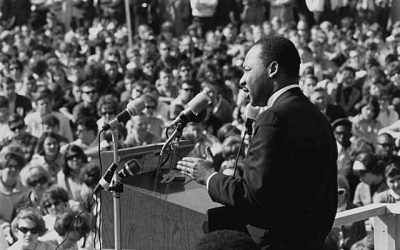My students had the extreme good fortune of being taught physics by David Harriman, a scholar of physics who is currently writing a book on the influence of philosophy on the history of physics. With his vast knowledge of physics and pedagogy, Mr. Harriman designed a new, and very effective method of teaching physics.
It seems that science is not taught in the public middle schools today–it has been replaced by…hands on “experiments” which are really pointless diversions. At the high school level, most students are exposed to some science, and most are required to take a physics class. But these physics classes generally suffer from a serious [methodological] problem.
Let me give you an example of this problem, and then I will explain it.
The following scenario will probably be familiar to many of you. It is half-way through the semester, and your physics teacher is going to discuss Newton’s Laws. You come into class, sit down, and the teacher begins to write on the board: “These are Newton’s three laws of motion. #1: Every body continues in its state of rest or of uniform motion in a straight line unless it is compelled to change that state by forces impressed on it. #2:…,” and so on. No explanation is given as to what observations, integrations, or discoveries Newton made in order to arrive at these laws of motion. No account is given of the long history behind Newton’s laws of motion–of the earlier theories that were refuted or were accepted and refined.
This method of teaching is extremely rationalistic. Scientific knowledge is presented as a series of commandments rather than as conclusions that have been reached by a laborious process of observation, experiment, and induction. If taught physics this way, a student’s grasp of the principles is necessarily detached from reality.
This approach to teaching physics also fails to provide students with a real understanding of the scientific method. If they are not exposed to the way in which a great scientist makes observations and then integrates them to arrive at an innovative conclusion, then they will not understand how science is done. Like the writing process, it will seem like an innate gift of born scientists, and they will never understand that they too can learn the process by which new discoveries are made. Because students are not learning the scientific method through real, historical examples of scientific discoveries, they usually have a few classes within the physics course devoted just to the scientific method. But the way this method is taught reflects the same rationalism. Students are told that the first step in the scientific process is to, “Choose a hypothesis.” Not a word is said about the process of observation that should lead you to a hypothesis, so the implication is that the hypothesis must be chosen on a whim or divinely inspired. Again, what they leave out is observation, integration, induction.
Mr. Harriman was acutely aware of the rationalistic method by which physics is taught in the schools today, and he devised a way of teaching physics that gives students a real, grounded, and complete understanding of the principles of physics. He determined that the best way to teach physics is to teach it chronologically.
By chronologically, I do not mean that he tried to chronicle every development in the history of physics. That would be practically impossible and pedagogically disastrous. He taught the essential discoveries of physics in their historical order of development.
The reason Mr. Harriman taught the history of physics, is that by teaching it chronologically you teach it inductively. Induction is the process of reasoning from concretes and lower-level abstractions to higher-level abstractions. The earliest discoveries in physics are necessarily the closest to the perceptual level. They are the simplest discoveries, and lay the groundwork for all later developments. So, if you study physics historically, you begin with these simple discoveries, close to the perceptual level. After these discoveries are grasped, you can proceed to the next stage in history, integrating the most basic discoveries with the observations made by the next scientist, and grasping a conclusion at a step more removed from the perceptual level. As you proceed through history, you are able to grasp principles on increasingly wider levels of abstraction.
[Dr. Leonard Peikoff] said the following in “Philosophy of Education.” “Knowledge is not a grab bag of unrelated items. It has a definite set of relations from the foundations in direct perceptions, on up to the more esoteric, complicated and advanced theories. Proper education has to reveal, or rather re-travel that structure with the student. It has to take them up the levels from the foundation, from the directly perceptual, letting them see at each point how one level proceeds from the earlier back to the directly given. That is the only way to tie advanced or abstract knowledge and concepts back to reality.”
As a result of Mr. Harriman’s approach to teaching physics, my students have not just memorized the principles of physics, they understand them clearly and concretely. Let me tell you a story that conclusively makes the case for this method of instruction. One day, Mr. Harriman was teaching the kids about the first evidence for the existence of atoms. He had spent several hours explaining many of the discoveries made by chemists, and he reached the Law of Combining Volumes, which states that the volumes of gases involved in a chemical reaction can always be expressed as a ratio of small integers. (For example, 2 L of H will combine with 1 L of O to make 2 L of steam.) Francisco, as focused and intent as always, thought about this for a minute, and then raised his hand and asked, “Does that mean that equal volumes of gases contain equal numbers of molecules?” If you don’t see the connection, don’t worry–I didn’t either at the time, and I had the benefit of Mr. Harriman’s class behind me. As it turns out, Francisco was anticipating the next development in science. Avogadro’s Hypothesis states exactly what Francisco said–that equal volumes of gases contain equal numbers of molecules.
There is no way, given the common approach to teaching physics, that Francisco could have anticipated the next discovery in the history of physics. It is because he had been taught the essential data that was available to Avogadro that he was able arrive at the same conclusion.
Mr. Harriman’s approach to teaching physics is proper [methodologically]. The students gain their knowledge inductively, starting with knowledge close to the perceptual level and building to greater and greater levels of abstraction.
There is an added advantage to teaching physics historically. It is fascinating to learn physics as a story–to learn how and why one development led to the next, and to learn it in the context of the lives of actual scientists. Mr. Harriman filled in some biographical detail when possible. Children love to be inspired by heroes–so knowing that Newton did most of his work in two years on a sheep farm, and hearing that Galileo did much of his work while under house arrest gives them more interest in each man’s scientific discoveries.
I have to mention that Mr. Harriman was once told by a high school administrator that children can listen to a lecture for no more then fifteen minutes. Well, he lives in San Diego and my classroom is in Newport Beach, so he had to drive up to teach the kids once a week. Every Monday, he lectured the kids for 3 hours, with only a fifteen minute break in the middle. They stayed attentive and involved the entire time. I think that shows how grossly the public schools underestimate children’s potential, but I think it is also testimony to Mr. Harriman’s method.
Excerpted from Lisa VanDamme’s Inspiring Lecture “Reclaiming Education,” March and April 1999, The Intellectual Activist. To learn more about Mr. Harriman’s course click here.
|
David Harriman, philosopher and historian of physics, is the originator of VanDamme Academy’s revolutionary science curriculum. An expert both in physics and in proper pedagogy, Mr Harriman developed and taught a two-year course on the history of physics for VanDamme Academy. VanDamme Academy is now making this revolutionary physics course, “Introduction to Physical Science,” available to the public. |




